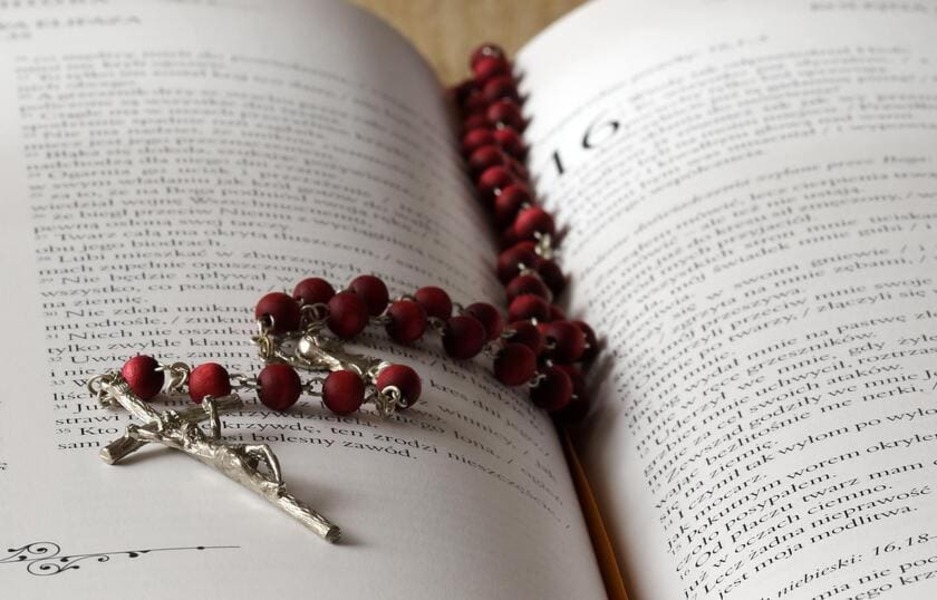He said to him, “What is written in the law? What do you read there?”
Luke 10:26
Table of Contents
- What is Lectio Divina?
- Why do we pray with Lectio Divina?
- When do we pray with Lectio Divina?
- How to pray Lectio Divina
- Related prayers
What is Lectio Divina?
Latin translation: “Divine Reading”
Lectio Divina means “divine reading” in Latin. It’s a meditative way of reading the Bible in which we let go of our own agendas and open ourselves to what God is trying to say to us.
When I was first introduced to Lectio Divina, I chose the passage from the Gospel where Jesus teaches the Our Father. What stuck out to me during this first attempt at Lectio Divina became the name of our app – the word “hallow,” which means “to make holy.”
Origin
Many historians and theologians credit St. Benedict of Nursia as the first teacher of Lectio Divina. St. Benedict spoke to the importance of divine reading in his Rule of St. Benedict, encouraging readers to live a life devoted to work and prayer (especially through reading). However, this method of prayer likely originated even earlier than the time of St. Benedict, who passed away during the 6th century.
It wasn’t until a few centuries ago that you could find a Bible in homes, hotels, and churches around the world with the invention of the printing press in the 15th century. It also wasn’t the norm that entire communities had the ability to read or write. Unlike today, with most Christians having Bibles in their homes or access to a digital Bible, communities shared physical Bibles and even relied on certain individuals to read scripture aloud. This practice of listening to Scripture read aloud was very popular in monastic communities — prompting them to “listen with their hearts.”
The modern resurgence of this ancient technique
While Lectio Divina has long been a technique prayed with, there was a resurgence in its popularity following the publishing of Dei Verbum, Vatican II’s Dogmatic Constitution on Divine Revelation. Promulgated by Pope Paul VI, Dei Verbum encourages us to continue renewing the Church through the Word of God. Similarly, Lectio Divina calls on us to see prayer as a renewal of our relationship with God through the Word.
God, who through the Word creates all things (see John 1:3) and keeps them in existence, gives men an enduring witness to Himself in created realities (see Rom. 1:19-20).
Dei Verbum, Ch. I, 3.
It’s not the same as Bible study
While Lectio Divina is a great way to study the Bible, it isn’t the same thing as a Bible study. Lectio Divina offers something more specific, more personal to you, in the moment you are praying. Bible studies lead us to interpret the Bible by asking questions and at times, doing research, and looking at the Bible as a whole. Lectio Divina, on the other hand, asks us to intentionally focus on a short section of Scripture. This prayerful focus could be one passage, one verse, or even just one word.
Why do we pray with Lectio Divina?
To become better listeners
There are countless ways to sit with God and grow closer to Him. From the Examen to the Rosary and everything in between, Christians might feel like their prayer toolbox is already full. However, Lectio Divina might become your favorite way to pray. Lectio Divina becomes more about divine listening than divine reading when we take the time to do it.
RELATED: How to Pray the Rosary | How to Pray the Daily Examen
This is why we pray Lectio Divina — to become better listeners of the Lord. When it feels like we can’t say the right thing in prayer, turn to Lectio Divina. Simply open the Bible to a passage, or select a meditation in Hallow, and try to listen well. In doing this, we might hear more clearly what God is asking of us — opening ourselves to peace, gratitude, and living rooted in Christ.
To remember the vitality of the Word
In September of 2005, the Vatican celebrated the 40th anniversary of Dei Verbum. Reminding us of the wisdom of the Word, Pope Benedict XVI explained that it is because of the Gospel that the Church lives. Therefore, it is through the Word that we, too, live.
It should never be forgotten that the Word of God is a lamp for our feet and a light for our path.
Pope Benedict XVI
When do we pray with Lectio Divina?
This prayer method is one of the most accessible types available to all of us. You can pray with the Word with Hallow, with a physical Bible, or even with a passage of Scripture you have memorized. God is with you and in Scripture at all times — whether it’s before you go to sleep or on your commute to work.
How to pray Lectio Divina
The time you spend praying the Lectio Divina is entirely up to you and varies by person. 20 minutes
- Read
Or when using Hallow, listen. Take a short passage from the Bible and listen to it carefully. Let it soak in.
If you’re not sure which verse or meditation to pray with first, we recommend starting with Hallow’s Introduction to Prayer Challenge.
If you’re praying with a Bible, maybe start with a passage you’ve heard before. For example, you could pray with an excerpt from any of the Psalms, Jesus’ visit to Mary and Martha (Luke 10:38-42), the story of the Woman at the Well (John 4), or the Beatitudes (Matthew 5:3-12). - Meditate
Then, after reading or listening for a second time, consider: What sticks out to you? Perhaps it’s a particular image, phrase, or single word. Let that be your focus, meditating on what might God be trying to show you through what stands out.
- Pray
Respond to the text and to God. Ask God to show you what He wants you to take from it. This could lead you to offer thanks, ask forgiveness, or simply talk with God about what the passage brought to your heart.
- Contemplate
Rest with God. Be aware of God’s presence with you. Listen for His voice.
At the end of the Lectio Divina sessions in Hallow, we close with the Our Father and the Sign of the Cross.
In the app, we have Scripture passages that have different themes and questions for reflection in praylists (such as ones related to love, humility, or sleep), and you can always pray Lectio Divina with the daily Gospel.
We hope to pray with you soon!
Related prayers
- How to Pray the Rosary
- How to Pray the Hail Mary
- How to Pray the Our Father
- How to Pray With the Gospels
- Contemplative Prayer



